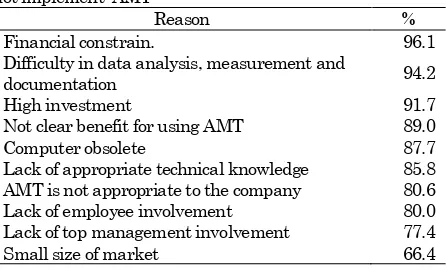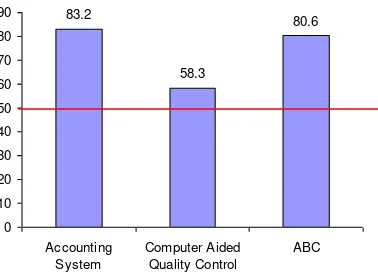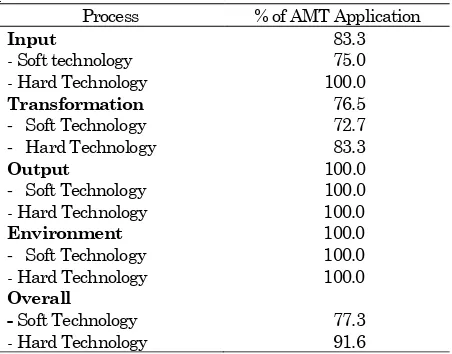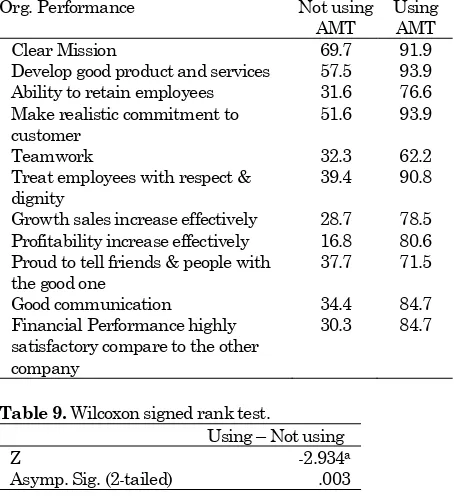Profiling Application of Advanced Manufacturing Technology
(AMT) in Indonesian SMEs
Jani Rahardjo
Industrial Engineering Department, Petra Christian University, Jl. Siwalankerto 121-131, Surabaya 60298, Indonesia
Email: [email protected]
Abstract: The role of SMEs in Indonesia is tremendous contribution to economic growth in Indonesia. Therefore, the Indonesian government has provided a great attention to the development of SMEs. The Indonesian government has been trying to encourage entre-preneurship development by supporting the development of small and medium enterprises in improving performance and increasing capacity. 99% of businesses are SMEs in Indonesia but only 56.7 % contribute to GDP is not as big as medium and large corporate contribution to GDP, mainly due to the limitations of SMEs still uses traditional technologies in the production process. Implementation of Advanced Manufacturing Technology on SMEs it is important to promote the development of SMEs in terms of productivity and effieceincy. In this study, researchers are exploring how far the use of AMT in improving the performance of SMEs in Indonesia. SMEs in the business sectors Food, Herbs and Craft will be taken as a case study in this research.
Keywords: AMT, SME, performance
Introduction
One of the effects of globalization on developing countries and developed countries is the accessibility to global markets resulting in increased economic growth (Raymond and Croteau, [12]). However, ac-cess to global markets the company is required to be able to meet customer needs in terms of quality and reliability of products, low prices and fast delivery (Monge et al, [9]). With the rapid growth of advanced technology, implementing the Advanced Manufac-turing Technology (AMT) will be a competitive advantage for the company to compete in the global market as well as to penetrate the market as evi-denced by Saleh and Ndubisi [12] that many Multi National Companies (MNCs) have success make mo-re efficient in the process production by adopting AMT. Judging from the success of the Multi-Natio-nal Corporations (MNCs) in adopting AMT, when applied to small industries especially have limited ability in applying certain technologies in operational processes, the question remains is: small firms will be able to compete in the global market place? How-ever, interesting to note is that during the world crisis in mid-1998 when the performance of the industry declined sharply, Small and Medium Enter-prises (SMEs) are able to survive and play an impor-tant role in creating economic survival and also ma-ke a significant contribution to economic growth both in developed and developing countries.
Literature Review
Advanced Manufacturing Technology (AMT)
ware (QCS), Statistical Process Control (SPC), Ex-pert systems, Manufacturing automation protocol (MAP), Database management systems, Mainframe, Minis, LAN/WAN, Online process instrumentation, Shop floor data capture, Graphics hardware, Auto-matic assembly, Flexible assembly systems, Manu-facturing cells, Automated warehousing/order pick-ing, Automatic testing equipment, Equipment con-trolled by programmable automation, Robot-based operations, Numerical control machines (NC), Auto-mated handling of materials, Flexible manufactur-ing systems (FMS) Implementations, Computer-based inventory management, Computer-Computer-based bar-coding, Computer-based maintenance management, Computer-based production scheduling, ISO, Total Quality Management (TQM), Just in Time (JIT) (Narain et al. [9]; Raymond [11]; and Salaheldin [13]). These AMTs are classified into Direct AMT, In-direct AMT, and Administrative AMT. Hardware base technologies are termed as Direct AMT. Soft-ware-based technologies used for product design and scheduling are termed as Indirect AMT, however, Administrative AMTs are used for integration and simplification of business processes (Beaumont et al. [1]):
1. Direct. The technology is used on the factory floor to cut, join, reshape, transport, store or otherwise modify materials. The examples include numerically controlled machinery and production line robots (CNC,DNC, Robotics, FMS, AMHS, AGV, etc)
2. Indirect. The technology is used to design pro-ducts and to schedule production. The examples include computer-aided design and drafting and scheduling system such as manufacturing resour-ces planning (MRP II) and production monitoring systems. (CAD, MRP, SPC, BC, MRP II, JIT, etc) 3. Administrative. The technology is used to give
administrative support to the factory and to inte-grate its operations with the rest of the organi-zation. The examples include job-costing system, ordering and inventory systems, accounting and cost control systems and communication systems supporting electronic data interchange, and other forms of electronic business. (ABC, OA, etc).
Monge et al. [9] classify AMT as Direct manufac-turing technologies (DMT), Administrative-informa-tion exchange – strategic technologies (AIET), Inte-grative manufacturing technologies (IMT), Adminis-trative-planning technologies (APT). Sun [21], divi-des AMT into four categories based on implementa-tion field: Planning and Controlling, Informaimplementa-tion re-source management, Product design and develop-ment, Factory automation. Sun et al. [19] develop the classification of AMT to be completed as below:
1. Planning and Controlling: ERP
2. Information resource management: Technology databases/product data management (PDM), 3. Product design and development, LAN-WAN/
In-tranet/shared database /internet, CAD, CAE. 4. Factory automation: Integrated design
proces-sing systems (CAD, CAE, CAM, CAPP), Nume-rical control machines, CNC, DNC, Computer aided inspection, FMS, FMC, automated tool change parts loading/ unloading robots, automat-ed storage-retrieval system (AR/RS) and Auto-mated guided vehicles (AGVs).
According to Small [18], and Vidyarthi and Laskhari [22], taxonomies of AMT are: Design and Engineer-ing Technologies (D‘PET), Fabricating / machining and Assembly (FMA), Automated Material Handling Technologies (AM HT), Automated Inspection and Testing Systems (AITS), Information Technologies (IT). Jonsson, [8], classifies AMT to five: design tech-nology (AMTDES), Manufacturing Techtech-nology (AMT MFG), Administrative Technology (AMT ADM), Computer-based transaction of data between sub-units (HINT1) and computer-based transaction of data between processes (HINT2). Small [17] classi-fied AMT into 4 groups based on Factor analysis as Design Technology, Manufacturing Technology, Ad-ministrative Technology and Resource Planning Technology. Though different in term of classifying the group of AMT, given that AMT is based prima-rily on computer information-based technology, ba-sically researchers classify AMT into hard techno-logy and soft technotechno-logy This broader view of AMTs facilitates the study of AMT implementation in SME because it permits the many dimensions of AMTs to be matched against several possible implementation strategies while studying the notion of fit and its im-plications for firm performance. Therefore, this con-ceptual classification of AMT forms the basis for the operationalization of AMT in this study.
Small Medium Enterprise (SME)
the informal sector and micro firms are included or not. In Indonesia, definition of SMEs varies amongst different Indonesian government agencies: for exam-ple, according to the Ministry of Industry, a Small Enterprise is a business establishment with assets (excluding land and building) of less than 200 million rupiah; Medium Enterprises are from 200 million up to 5 billion rupiah; and firms of more than 5 billion rupiah are considered as Large Enterprises. A differ-rent definition is given by the Central Bureau of Sta-tistics (Biro Pusat Statistik [BPS]), which classifies enterprises systematically according to the number of fulltime employees. From 0 to 4 workers a firm is classified as a Cottage or Household Enterprise (CHE), those with 5 to 19 workers as Small Enter-prises (SEs), and those with more than 19 as Medi-um Large Enterprises (MLEs). According to the defi-nition of the Ministry for Cooperative, Small and Me-dium Enterprises, SMEs involve people activity on a small to medium scale, with criteria as follows: 1) they have maximum net assets of up to 10 billion rupiah, excluding land and buildings; 2) they are owned by Indonesians; 3) they comprise independent companies not owned by a large company and direct-ly or indirectdirect-ly affiliated with a large enterprise; and 4) they are individual companies, with or without le-gal entity status.
Methods
Data
Two hundred and fifty three samples were collected from a few exhibitions held in Indonesia. The sample is taken from food and beverage industry, herbal in-dustry and craft inin-dustry. The data collection me-thod employed was distributed of questionnaire to the participants of the exhibition. Questionnaires were distributed to all exhibitors, but only a limited number of exhibitors agreed to participate in the stu-dy. The methodology used for data analysis is des-criptive, chis-square test and Wilcoxon Sign Method to test the impact of AMT on company performance. These testing hypothesis use 5% of the significance level.
Results and Discussion
Organization Profile
Sample obtained from this survey is 253 respondents and consists of some of the following industries: Food & Beverage industry of 45.1%, 15,4% of Herbal In-dustry and Craft InIn-dustry of 37.2 %.
The length of operating companies is very diverse ranging from 6 months to tens of years. SME can be divided into 3 groups based on Indonesian SME definition, namely micro, small and medium.
Table 1. AMT application.
AMT Freq. Valid % Cumulative %
No 155 61.3 61.3
Yes 98 38.7 100.0
Total 253 100.0
Table 2. Percentage of the reason why the company does not implement AMT
Reason %
Financial constrain. 96.1
Difficulty in data analysis, measurement and
documentation 94.2
High investment 91.7
Not clear benefit for using AMT 89.0
Computer obsolete 87.7
Lack of appropriate technical knowledge 85.8
AMT is not appropriate to the company 80.6
Lack of employee involvement 80.0
Lack of top management involvement 77.4
Small size of market 66.4
Limitation of sales turnover for the micro category is less than 100 Million Rupiah, small is between 100 Million to 1 Billion Rupiah and medium industry is between 1 Billion to 10 Billions Rupiah. From the survey, it is found that the percentage of micro industry is 54.5 %, small industry is 20.2% and 20.6% of respondent as a medium industries. Average of employee in the company is 43 people and ratio skilled employee to total employees is 15.3%.
Type of ownership is a family business for 62.1%, 24.1% is Share Holding and 13.8% is joint venture. Type of ownership as a family business is still dominant in Indonesian SME.
AMT Application
Table 1 explains that 98 companies or 38.1 % of the total respondents are implemented AMT. And the rest is not using the AMT. The reason why they do not use the AMT is very diverse. The high reasons are financial constrain and high investment for AMT application. The other reasons are not clear in
Knowledge of AMT such as not clear of AMT’s
benefit, lack of appropriate technical knowledge and difficulties data analysis, measurement and docu-mentation.
All reasons of why the company does not apply AMT can be seen in table 2. Interesting reasons when the company does not apply AMT because does not re-quire AMT are around 80.6%. Therefore percentage of the company implement AMT becomes 76.6 %.
Figure 1. AMT application in input process
Figure 2. AMT application in transformation process
Figure 3. AMT application in output process
MIS, Automated Drafting Technologies, CAD, CAE, Automated Statistical Process Control, Quality Function Deployment, CRM, and Forecasting can be classified as soft technology in the input process. Hard technology can be classified as follows Compu-ter Equipment, LAN, WAN, Automation and loading and unloading.
In Figure 1, the use of hard technology in the input process are four hard technologies, but only 3 of hard technology is over 50 % highly used of AMT such as Computer equipment, LAN, WAN. Ratio of usage of AMT in the input process is 75%. The use of soft technology at the input process is 8 and only 4 which have values above 50% high usage such as MIS, CAD, CRM and Forecasting Software. The percent-tage of soft technology used in the process input is
50%. From the input process, the use of hard tech-nology is higher than the use of soft techtech-nology.
Classification of soft technology in the Transforma-tion process can be described as ISO, HACCP-GMP, Database Management System, Kaizen, Zero, Defect Program, MRPII, ERP, CPM TQM, JIT, CAPP, and SCM. And as a hard technology are CAM, CNC, CIM, Automation of Testing equipment, Bar Coding, RFID. As the output is classified as a soft technology are Accounting System and Activity Based Costing (ABC). Classification of hard technology in Transfor-mation process is Computer Aided Quality Control perfumed on final product. Figure 2 indicate the use of AMT in Transformation Process. In the process of transformation can be known that the highest use of hard technology is Bar Coding Technique (80%). Use of Soft Technology in the transformation process is ISO, HACCP, GMP, Database Management, MRP II, TQM, and SCM. There are 6 soft technology used in the process of transformation, this can be said that there are 72.7% the use of soft technology in the transformation process. The use of hard technology in the transformation process is 83.3 %. From both technologies, the use of hard technology in transfor-mation process is greater than soft technology. Hard technology is the core of the transformation process. So hard technology should always be in the process of transformation, but to optimize production and to improve productivity and needed a soft technology. For example is the use of soft technology, such as TQM, MRP and SCM were used for the optimization of productivity. Besides the basic requirements for food & beverage industry and Herbal industry are GMP-HACCP, ISO, and data base management.
In the Output Process, Technology can be classified into hard technology such Computer Aided Quality Control as control of quality product and soft techno-logy is Accounting System and ABC as control of financial system.
Figure 3 shows that two soft technology used it as an Accounting system and ABC. The use of soft tech-nology in output process is 100%. Another case with hard technology, there is only one as hard technology and used it so that the use of hard technology in output process is 100%. Comparing from two tech-nologies, the use of hard technology is similar than the use of soft technology.
that use of soft technology in environment is 100%. Likewise the use of soft technology as OSHAS has 74.4 % of the respondent who said that the use of this OSHAS high and very high. Table 3 indicates that overall of use of soft technology is 77.3 % and 91.6 % of hard technology.
Relationship between the AMT Application and Sales Turnover, Profitability and Organi-zational performance.
There is a presumption that the large company easier to implement AMT, this is in the associate with the availability of resources both financial and human resources knowledge.
Table 8 shows that Comparison of the number of industries that use AMT and industries that not use AMT, there are significance increase. In the category < 100 Millions (Micro Enterprises) seen that the number of industries that do not use as much as 87.7% and is higher that small enterprises and medi-um enterpriseCross Tabulation data in Table 4 can be tested whether there is a relationship between the use of AMT and Org. Sales turnover.
The result from the Table 5, prove that value of significance in Pearson chi-square less than level of significance. So there is significance relationship bet-ween the use of AMT and Organizational sales turn-over. Table 6 shows that the percentage of company that uses the AMT has increased the profitability higher than the company does not use the AMT.
A significance of increasing in the percentage of number of industries show that the use of AMT will impact on profitability. The chi square test result in Table 7 shows that value of significance as 0.00 is less than 5 % of significance level. There is relation-ship between the companies which use of AMT with Profitability rate.
Table 8 the value of organizational performance which use of the AMT and does not use of the AMT is different. Companies which use of AMT are better performance than companies which do not use of AMT. This indicates that Using AMT has a very
high benefit to reach a company’s aim which has
been stated in the mission and vision. Its can provide benefits to improving the quality of product and services. It can increase financial performance in the growth sales turnover and profitability
To test the differences impact of AMT between com-panies which use of AMT and not use AMT, Wil-coxon Signed Rank test in table 9 has been proven that there is significant difference impact of AMT with 5% of significance level.
Table 3. Percentage of AMT application in production process
Process % of AMT Application
Input
Table 7. Chi-Square tests for profitability with use of AMT
Value df
Asymp. Sig. (2-sided)
Pearson Chi-Square 1.003E2a 3 .000
Likelihood Ratio 115.000 3 .000
Linear-by-Linear
Association 81.557 1 .000
N of Valid Cases 269
Table 8. Relationship between the use of AMT with the organizational performance.
Org. Performance Not using
AMT
Using AMT
Clear Mission 69.7 91.9
Develop good product and services 57.5 93.9
Ability to retain employees 31.6 76.6
Make realistic commitment to customer
51.6 93.9
Teamwork 32.3 62.2
Treat employees with respect & dignity
39.4 90.8
Growth sales increase effectively 28.7 78.5 Profitability increase effectively 16.8 80.6 Proud to tell friends & people with
the good one
37.7 71.5
Good communication 34.4 84.7
Financial Performance highly satisfactory compare to the other company
30.3 84.7
Table 9. Wilcoxon signed rank test.
Using – Not using
Z -2.934a
Asymp. Sig. (2-tailed) .003
Conclusion
This research concludes that the AMT Application in Indonesia is 76.6% and the rest does not use AMT. The highest reason the company does not use the AMT is financial constraint amounting to 96.1%. If company look at the clear of AMT benefit such as growth of annual sales turnover, increased profitabi-lity and high organizational performance, the compa-ny will be provided a high chance to open new mar-ket and will increase to national economic growth.
AMT has been classified in two groups of soft tech-nology and hard techtech-nology. The AMT application in hard technology widely used in the input process, transformation, output process, and Environment. Soft technology is being widely used in the transfor-mation process. This means that for the optimization of production processes will be more emphasis on the use of soft technologies. To control product quality is more emphasis on hard technology. Both techno-logies including hard technology and soft technology are mutual support or complementary to one ano-ther. The basis of the production process begins with the use of hard technology, followed with the use of soft technology as an optimization in production sys-tem.
Analysis of the relationship between the use of AMT with sales turnover, profitability and Organizational performance obtained results that are significance relationship between AMT Application and annual sales turnover, profitability rate, Organizational performance. Companies with high sales turnover and high profitability are more applied AMT than companies with low sales turnover and low profitability. Thus small company with low profitability and low sales turnover is more difficult to implement AMT. Many micro or small enterprises tend not to use the AMT because of financial difficulties and also AMT does not appropriate to his company. Micro and Small Enterprises are still using manual production process due to low market demand and low quality requirements.
References
1. Beaumont, N., Schroder, R. and Sohal, A. Do Foreign-Owned Firms Manage Advanced Manu-facturing Technology Better, International Jour-nal of Operations & Production Management, 22(7), 2002, pp 759-71.
2. Boyer K.K., Leong G.K., Ward P.T and Kra-jewski L.J, Unlocking the Potential of Advanced Manufacturing Technologies, Journal of Opera-tion Management, 15, 1997,pp. 331-347
3. Boyer K.K., and Pagell M. Measurement Issues in Empirical Research: Improving Measures Operation Strategy and Advanced Manufac-turing Technology, Journal of Operation Mana-gement, 18, 2000, pp. 361-374
4. Dangayach, G and Deshmukh, S., Advanced Manufacturing Technology Implementation: Evi-dence from Indian Small and Medium Enter-prises (SMEs), Journal of Manufacturing Tech-nology Management, 16(5), 2005, pp. 483-496. 5. Dangayach, G.S and Deshmukh, S.G, Practice
Of Manufacturing Strategy: Evidences from Select Indian Automobile Companies, Internatio-nal JourInternatio-nal of Production Research, 39(11), 2001, pp. 2353-93.
6. Deruntz, B. D., and Turner, R. M., Organizatio-nal Considerations for Advanced Manufacturing Technology, Journal of Technology Studies, 3, 2001, pp. 4-17.
7. Hashim, M.K, SMEs in Malaysia: A brief Handbook, , August Publication, Malaysia, 2007 8. Jonsson, P., An Empirical Taxonomy of
Advanc-ed Manufacturing Technology, International Journal of Operations & Production Manage-ment, 20(12), 2000, pp. 1446-74.
9. Monge, C.A.M., Rao, S.S., Gonzales, M.E.,and Sohal, A.S.. Performance Measurement Of AMT: A Cross-Regional Study. Benchmarking An International Journal, 13(1/2), 2006 pp. 135-146. 10.Narain, R., Yadav, R.C., & Jiju A., Productivity
11. Rahman, A. A.. Buyer-Supplier Relationships in Advanced Manufacturing Technology Acquisi-tion and ImplementaAcquisi-tion in Malaysia. Inter-national Journal of Economic and Management, 2(1), 2008, pp. 95-126
12. Raymond L., Operations Management and Ad-vanced Manufacturing Technologies in SMEs: A Contingency Approach. Journal of Manufactur-ing Technology Management, 16(8), 2005, pp. 936-955.
13. Strategic Development of SMEs through Advan-ced Manufacturing Systems: A Configurational Perspective, Journal of Industrial Management & data Systems, 106(7), 2006, pp. 1012-1032. 14. Saleh, A. S., and Ndubisi, N. O. An Evaluation of
SME Development in Malaysia, International Review of Business Research Paper, 2(1), 2006, pp. 1-14.
15. Salaheldin, I. S., The Impact Of Organizational Characteristics on AMT Adoption: A Study of Egyptian Manufacturers, Journal of Manufac-turing Technology Management, 18(4), 2007, pp. 443-460.
16. Small, M.H. and Yasin, M.M. Developing a Framework for the Effective Planning and Im-plementation of Advanced Manufacturing Tech-nology, International Journal of Operations & Production Management, 17(5), 1997, pp.468-89.
17.Small, M., Assessing Manufacturing Performan-ce: An Advanced Manufacturing Technology Portfolio Perspective, Industrial Management & Data Systems, 99(6), 1999, pp.266-278.
18.Small, M.H. and Yasin, M.. Advanced Manufac-turing Technology Adoption and Performance: The Role of Managament Information System Departments, Integrated Manufacturing System Journal, 14(5), 2003, pp.409-422.
19.Schroder, R., and Sohal, A.S, Organisational Characteristics Associated with AMT Adoption: Towards a Contingency Framework, Internatio-nal JourInternatio-nal of Operations & Production Manage-ment, 19(12), 1999, pp. 1270-1291.
20.Sun, H.,Human Resources Development and In-tegrated Manufacturing Systems. Integrated Manufacturing Systems, Omega, 12(3), 2001, pp 195-204.
21.Sun, X. L, Tian, Y.Z, Cui, G.G., The Empirical Study on the Impact of Advanced Manufacturing Technology on Organizational Structure and Hu-man Resources Management, Proceeding Inter-national Conference on Management Science & Engineering (14th), August 20-22,2007, pp.
1548-1553.



